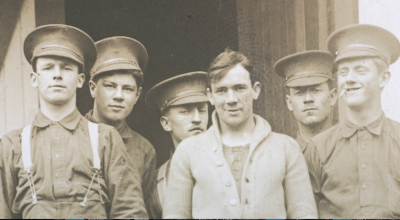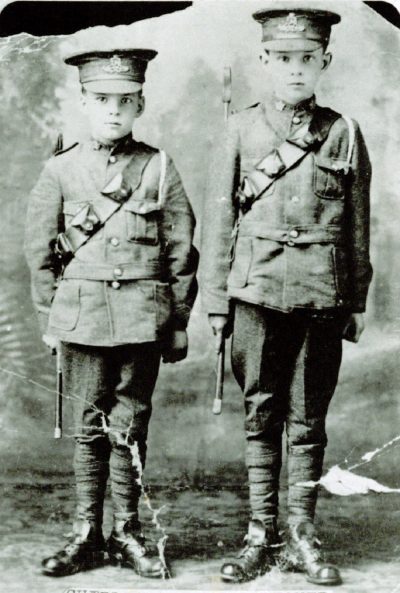#105 From Aldergrove to Vimy Ridge
Canucks in Khaki: Langley, the Lower Mainland, and the Great War of 1914 to 1918
by Warren Sommer
Fort Langley: Legacy Heritage Consultants, 2017
$39.95 / 9780995803701
an extract from the foreword by Mark Forsythe
First Published March 16, 2017
*
 A biting wind whips up from the Douai Plain; stabs of rain push us back from the ridge.
A biting wind whips up from the Douai Plain; stabs of rain push us back from the ridge.
We huddle beneath the Vimy monument, reading the names of 11,285 Canadian soldiers killed in France. Each name etched into white limestone, each name with no known grave.
A young Canadian guide says soldiers’ remains still emerge from farmers’ fields below. Sometimes they can be identified, their humanity restored once again.
Hours earlier my wife and I had located the grave of my great-uncle, Albert Ernest Rennie, at nearby Sains-en-Gohelle. We signed the Commonwealth War Graves register, placed Canada’s colours at his headstone, and reflected on a life that might have been.
Albert was killed during preparations for the Battle of Hill 70 at age twenty-one. I heard nothing about him while growing up perhaps because his death was too painful for his sisters (my grandmother and aunt) to spell out to a young boy. Recently I have been on a journey to learn more about Albert and to better understand this bloody time that still echoes through families and communities.

Events from a century ago can seem remote, even irrelevant. But in human terms, this is the mere skip of a stone. It is the time of our parents, grandparents, or great-great-aunts. The details of their lives and challenges connect us to that history in a meaningful, intimate way. Langley historian and author Warren Sommer understands this deeply. His own story intersects with the Great War: through a grandfather killed in battle, a grandmother who worked in a munitions factory. Sommer embarked on a quest to document, honour, and share the experiences of soldiers and citizens from Langley and nearby parts of the Lower Mainland. Twenty-five years later, Canucks in Khaki is the exemplary result.
The Great War exploded during the summer harvest in 1914; local farm boys traded tools for rifles. British Columbians enlisted with gusto, in numbers that were the highest per capita in the country. Half of those who lived in B.C. had British roots, all the more so in the Fraser Valley.

When the call came to defend mother country and empire, men scrambled to sign up with local battalions. Fifteen-year-old William Barrett ran away from his Glen Valley home for a war adventure that some boasted would be over by Christmas. The Abbotsford Post editor was even more optimistic, declaring, “The war will be over in time for us to enjoy the Abbotsford Fair.”

On the home front, people rallied to raise money for the Patriotic Fund that assisted soldiers’ families. Propaganda flowed from church pulpits and the pages of the press. Women knitted warm socks for soldiers overseas, and they began doing men’s work on farms and in factories. By war’s end, they would have the vote. Casualties continued to mount on the front. Rev. James Henry White had three sons in uniform, including his youngest, Harold. Upon learning that Harold had been seriously wounded, James wrote: “I would give all I have in the world to be with you . . . When your blood flows it comes straight from my heart.” Harold did not survive, a fate he shared with more than sixty thousand other Canadians.
Almost four hundred soldiers and nursing sisters enlisted from Langley. The wartime experiences of dozens of these are profiled in Canucks in Khaki. (Sommer’s research uncovered one hundred names not previously associated with Langley.) Their struggles are woven into a meticulously researched narrative that traces Canada’s role through the arc of war: diplomatic failure, critical battles, victories, losses, brave actions, and the rapacious demand for more soldiers.

Personal photographs, archival sources and press accounts also inform this book, but it is the individual voices of soldiers and their family members that are most gripping. Letters and diaries speak from training camps, transport ships hunted by U-boats, hospitals under attack, and rat-infested trenches choked in mud. Langley’s Hector Jackson learned what sounds to ignore and which to flee from, as he told his mother in a letter: “Gradually you can recognise the various whines and know just where to expect them to burst . . . Every now and then an eccentric one comes over and upsets my theories, but as long as it does not hit me it is all right.”
Specific battles and locations were usually omitted from letters to satisfy censors, but the longing for home is a constant. Alexander Eugene Ross from Aldergrove penned a short letter to his family and his sweetheart in January 1918 “using the light of the torch.” He had served in the trenches for better than a year. “God grant that during the next one [year] I will be away as I feel I have seen enough . . . but we should not worry as I am still on deck and in first rate health.” Two days later, a stray shell exploded near him; Ross died an hour later. His death was but one example of the random “wastage” that on a typical day resulted in up to seven thousand British and Empire soldiers being killed or wounded.

The Great War unleashed gruesome ways to kill, maim, or destroy: machine guns, poisonous gases, heavy artillery barrages, tanks, and flame-throwers. “The war to end all wars” most certainly did not. Worldwide carnage erupted again just two decades later; and many of today’s conflicts in the Middle East can be traced to arbitrary borders drawn by the imperial powers of a century ago.

Canucks in Khaki documents how Canadians responded to unprecedented challenges on the battlefield and at home. We are reminded of the diplomatic failures that precipitated the Great War and its incomprehensible toll in soldiers’ and civilians’ lives. During this centennial of Canada’s transformative victory at Vimy Ridge, it is important to remember these lessons. Warren Sommer’s clear-eyed and personal book is a powerful place to begin.
*
Mark Forsythe is a former CBC Radio host and co-author with Greg Dickson of From the West Coast to the Western Front: British Columbians and the Great War (Harbour, 2014).

Langley, 125: A Celebration (Fort Langley: Birthplace of B.C. Gallery, 1998). With Kurt Alberts.
From Prairie to City: A History of the City of Langley (City of Langley, 1999)
From Far and Wide: Cultural Diversity in North Vancouver (North Shore Multicultural Society, 2000)
Frail Memorials: The Cemeteries of Langley (Corporation of the Township of Langley, 2005),
The Ambitious City: A History of North Vancouver (Harbour, 2007), published to mark the City of North Vancouver’s centennial; and
Nothing Without Effort: A History of Langley (Corporation of the Township of Langley, 2008).